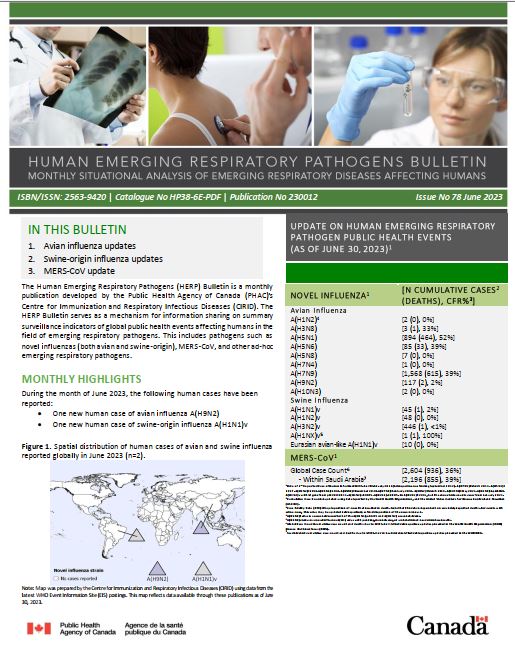Human emerging respiratory pathogens bulletin: Issue 78, June 2023
Download in PDF format
(510 KB, 3 pages)
Organization: Public Health Agency of Canada
Date published: 2023-07-11
Monthly situational analysis of emerging respiratory diseases affecting humans (data to June 30, 2023).
In this bulletin
- Avian influenza updates
- Swine influenza updates
- Middle East respiratory syndrome coronavirus (MERS-CoV) update
Novel influenzaFootnote 1 |
Cumulative Case CountFootnote 2 |
Deaths |
Case Fatality Rate %Footnote 3 |
|---|---|---|---|
Avian Influenza |
|||
A(H1N2)Footnote 4 |
2 |
0 |
0% |
A(H3N8) |
3 |
1 |
33% |
A(H5N1) |
894 |
464 |
52% |
A(H5N6) |
85 |
33 |
39% |
A(H5N8) |
7 |
0 |
0% |
A(H7N4) |
1 |
0 |
0% |
A(H7N9) |
1,568 |
615 |
39% |
A(H9N2) |
117 |
2 |
2% |
A(H10N3) |
2 |
0 |
0% |
Swine Influenza |
|||
A(H1N1)v |
45 |
1 |
2% |
A(H1N2)v |
48 |
0 |
0% |
A(H3N2)v |
446 |
1 |
<1% |
A(H1NX)vFootnote 5 |
1 |
1 |
100% |
Eurasian avian-like A(H1N1)v |
10 |
0 |
0% |
MERS-CoVFootnote 1 |
Cumulative Case CountFootnote 2 |
Deaths |
Case Fatality Rate %Footnote 3 |
Global Case CountFootnote 6 |
2,604 |
936 |
36% |
- Within Saudi ArabiaFootnote 7 |
2,196 |
855 |
39% |
Footnotes
|
|||
The Human Emerging Respiratory Pathogens (HERP) Bulletin is a monthly publication developed by the Public Health Agency of Canada (PHAC)'s Centre for Immunization and Respiratory Infectious Diseases (CIRID). The HERP Bulletin serves as a mechanism for information sharing on summary surveillance indicators of global public health events affecting humans in the field of emerging respiratory pathogens. This includes pathogens such as novel influenzas (both avian and swine-origin), MERS-CoV, and other ad-hoc emerging respiratory pathogens.
Monthly Highlights
During the month of June 2023, the following human cases have been reported:
- One new human case of avian influenza A(H9N2)
- One new human case of swine-origin influenza A(H1N1)v
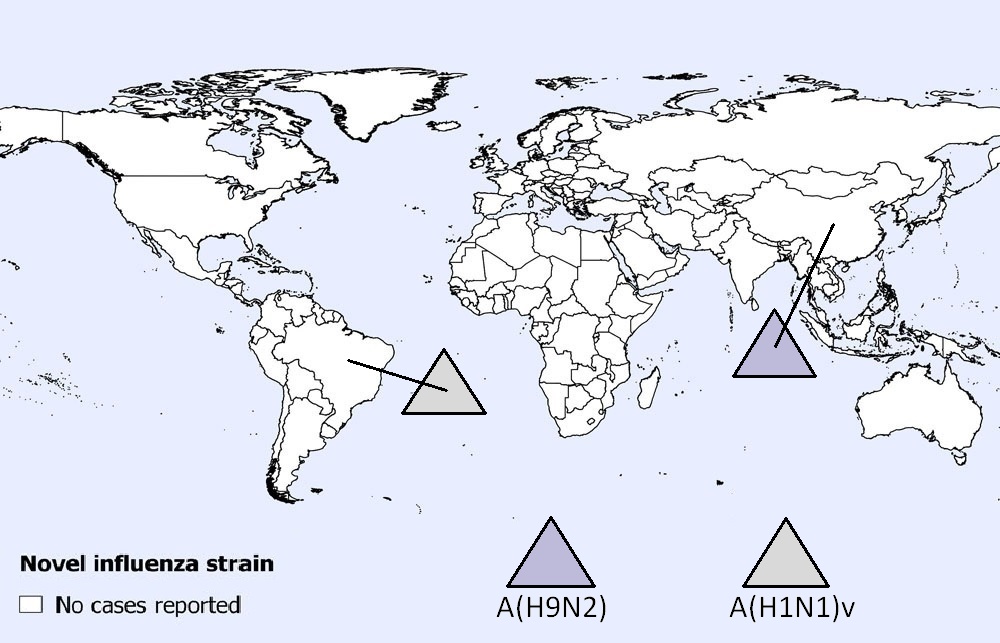
Figure 1 - Text description
One A(H9N2) case was reported in China.
One A(H1N1)v case was reported in Brazil.
Note: Map was prepared by the Centre for Immunization and Respiratory Infectious Diseases (CIRID) using data from the latest WHO Event Information Site (EIS) postings. This map reflects data available through these publications as of June 30, 2023.
Avian influenza updates
Avian influenza A(H3N8)
The most recent human case of avian influenza A(H3N8) was reported in March 2023 from China.
There have been three human cases, including one fatality, worldwide since the first detection in 2022. The previous two cases were reported from Henan and Hunan provinces in China in April and May 2022 respectively and recovered. The case fatality rate (CFR) for A(H3N8) is 33%; however, with only three human cases to date, the full spectrum of disease is highly uncertain.
Avian influenza A(H5N1)
The most recent human cases of avian influenza A(H5N1) were reported in May 2023 in the United Kingdom.
Since 2022, 13 human cases of A(H5N1) have been reported worldwide (2022 n=5, 2023 n=8) in Cambodia (2), Chile (1), China (2), Ecuador (1), Spain (2), United Kingdom (3), United States (1), Vietnam (1; tentative). Of these cases, 11 belonged to clade 2.3.4.4b and two belonged to clade 2.3.2.1c (both from Cambodia).
In Canada, a significant number of A(H5N1) detections associated with the current 2021-2023 A(H5N1) clade 2.3.4.4b epizootic have been reported in domestic, backyard, and wild bird populations, as well as other animal species. No domestically acquired human A(H5N1) infections have ever been reported in Canada. In 2014, Canada (Alberta) reported a single fatal case of A(H5N1) in a resident returning from travel in China.
Since the emergence of A(H5N1) in humans in 1997, 894 human cases of A(H5N1) have been reported globally, with a CFR of 52%.
Avian influenza A(H5N6)
The most recent human case of avian influenza A(H5N6) was reported in May 2023 in China.
In 2023, two cases of A(H5N6) have been detected. A total of 85 laboratory-confirmed human cases of avian influenza A(H5N6), including at least 33 deaths (CFR: 39%) have been reported globally since 2014. Since January 2021, 59 cases of avian influenza A(H5N6) have been reported globally; 32 cases in 2021, 25 cases in 2022 and 2 cases in 2023 (Figure 2); the majority of cases (58) were reported from China and one case was reported from Lao PDR (Figure 3). No cases have been reported in Canadian residents.
Avian influenza A(H9N2)
One new human infection of A(H9N2) was reported in June 2023 in China.
The case was a 6-year-old female from the province of Sichuan with an illness onset date of May 30, 2023, and was detected through influenza-like-illness (ILI) surveillance. The case reported mild symptoms without hospitalization and had potential exposure to a live poultry market in Bazhong City. No symptoms in the rest of the family have been reported.
In 2023, 10 cases of A(H9N2) have been detected. Since the emergence of this virus in the human population in 1998, 117 cases have been reported worldwide, with a CFR of 2%. No cases have been reported in Canada.
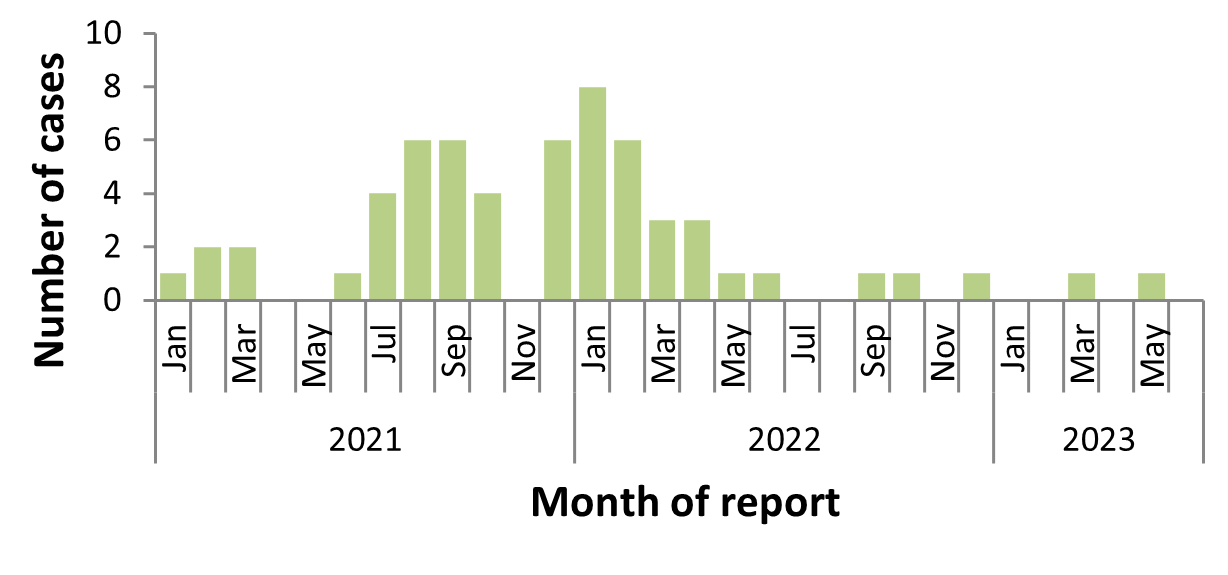
Figure 2 - Text description
| Year | Month | Cases |
| 2021 | Jan | 1 |
| Feb | 2 | |
| Mar | 2 | |
| Apr | 0 | |
| May | 0 | |
| June | 1 | |
| July | 4 | |
| Aug | 6 | |
| Sep | 6 | |
| Oct | 4 | |
| Nov | 0 | |
| Dec | 6 | |
| 2022 | Jan | 8 |
| Feb | 6 | |
| Mar | 3 | |
| Apr | 3 | |
| May | 1 | |
| June | 1 | |
| July | 0 | |
| August | 0 | |
| Sep | 1 | |
| Oct | 1 | |
| Nov | 0 | |
| Dec | 1 | |
| 2023 | Jan | 0 |
| Feb | 0 | |
| Mar | 1 | |
| Apr | 0 | |
| May | 1 | |
| June | 0 |
Note: Graph was prepared by the Centre for Immunization and Respiratory Infectious Diseases (CIRID) using data from the WHO EIS postings and the Hong Kong Centre for Health Protection (CHP) press releases. This graph reflects data available as of June 30, 2023.
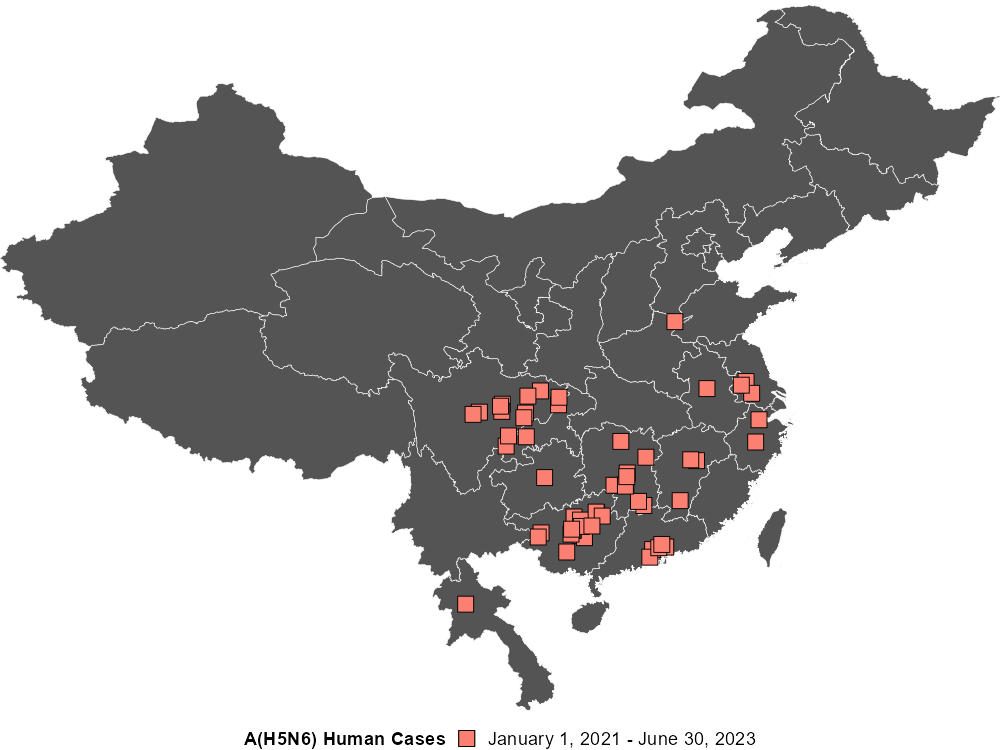
Figure 3 - Text description
Four cases were reported out of Yongzhou, Hunan Province, People's Republic of China.
Three cases were reported out of Guilin, Guangxi Zhuang Autonomous Region, People's Republic of China.
Three cases were reported out of Huizhou, Guangdong Province, People's Republic of China.
Three cases were reported out of Liuzhou, Guangxi Zhuang Autonomous Region, People's Republic of China.
Two cases were reported out of Baise, Guangxi Zhuang Autonomous Region, People's Republic of China.
Two cases were reported out of Chengdu, Sichuan Province, People's Republic of China.
Two cases were reported out of Chenzhou, Hunan Province, People's Republic of China.
Two cases were reported out of Dongguan, Guangdong Province, People's Republic of China.
Two cases were reported out of Guangxi Zhuang Autonomous Region, People's Republic of China.
Two cases were reported out of Hechi, Guangxi Zhuang Autonomous Region, People's Republic of China.
Two cases were reported out of Hengyang, Hunan Province, People's Republic of China.
Two cases were reported out of Jiangxi Province, People's Republic of China.
Two cases were reported out of Sichuan Province, People's Republic of China.
Two cases were reported out of Tongnan District, Chongqing Municipality, People's Republic of China.
Two cases were reported out of Zhenjiang, Jiangsu Province, People's Republic of China.
One case was reported out of Anhui Province, People's Republic of China.
One case was reported out of Bazhong, Sichuan Province, People's Republic of China.
One case was reported out of Changde, Hunan Province, People's Republic of China.
One case was reported out of Deyang City, Sichuan Province, People's Republic of China.
One case was reported out of Fuzhou, Fujian Province, People's Republic of China.
One case was reported out of Ganzhou City, Jiangxi Province, People's Republic of China.
One case was reported out of Guizhou Province, People's Republic of China.
One case was reported out of Hangzhou, Zhejiang Province, People's Republic of China.
One case was reported out of Kaijiang County, Sichuan Province, People's Republic of China.
One case was reported out of Laibin, Guangxi Zhuang Autonomous Region, People's Republic of China.
One case was reported out of Langzhong City, Sichuan Province, People's Republic of China.
One case was reported out of Luang Prabang Province, Lao People's Democratic Republic (the).
One case was reported out of Nanning, Guangxi Zhuang Autonomous Region, People's Republic of China.
One case was reported out of Puyang City, Henan Province, People's Republic of China.
One case was reported out of Xuanhan County, Sichuan Province, People's Republic of China.
One case was reported out of Yangzhou, Jiangsu Province, People's Republic of China.
One case was reported out of Yibin, Sichuan Province, People's Republic of China.
One case was reported out of Yongchuan District, Chongqing Municipality, People's Republic of China.
One case was reported out of Zhejiang Province, People's Republic of China.
One case was reported out of Zigong City, Sichuan Province, People's Republic of China.
One case was reported out of Nanning, Guangxi Province, People's Republic of China.
One case was reported out of Guangxi Zhuang Autonomous Region, People's Republic of China.
One case was reported out of Changsa, Hunan Province, People's Republic of China.
One case was reported out of in Qingyuan, Guangdong Province, People's Republic of China.
Note: Map was prepared by the Centre for Immunization and Respiratory Infectious Diseases (CIRID) using data from the WHO EIS postings and the Hong Kong Centre for Health Protection (CHP) press releases. This map reflects data available through these publications as of June 30, 2023.
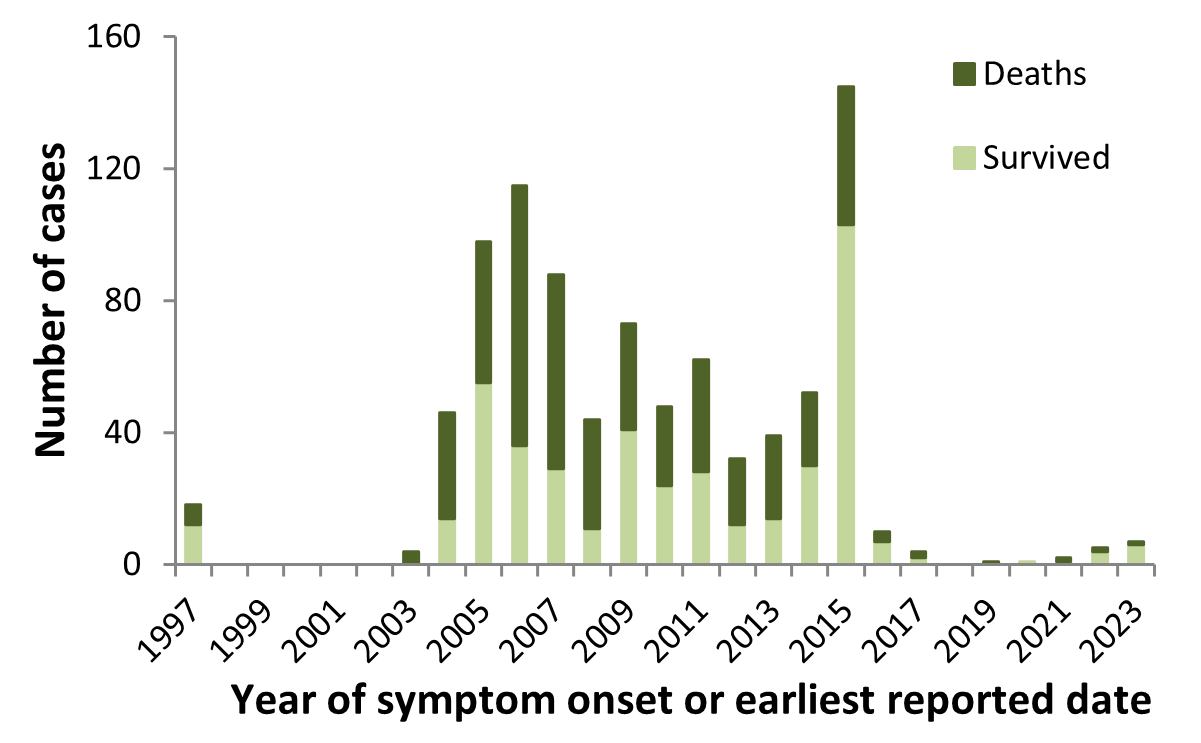
Figure 4 - Text description
| Year | Number of Cases | Deaths | Survived |
|---|---|---|---|
| 1997 | 18 | 6 | 12 |
| 1998 | 0 | 0 | 0 |
| 1999 | 0 | 0 | 0 |
| 2000 | 0 | 0 | 0 |
| 2001 | 0 | 0 | 0 |
| 2002 | 0 | 0 | 0 |
| 2003 | 4 | 4 | 0 |
| 2004 | 46 | 32 | 14 |
| 2005 | 98 | 43 | 55 |
| 2006 | 115 | 79 | 36 |
| 2007 | 88 | 59 | 29 |
| 2008 | 44 | 33 | 11 |
| 2009 | 73 | 32 | 41 |
| 2010 | 48 | 24 | 24 |
| 2011 | 62 | 34 | 28 |
| 2012 | 32 | 20 | 12 |
| 2013 | 39 | 25 | 14 |
| 2014 | 52 | 22 | 30 |
| 2015 | 145 | 42 | 103 |
| 2016 | 10 | 3 | 7 |
| 2017 | 4 | 2 | 2 |
| 2018 | 0 | 0 | 0 |
| 2019 | 1 | 1 | 0 |
| 2020 | 1 | 0 | 1 |
| 2021 | 2 | 1 | 1 |
| 2022 | 5 | 1 | 4 |
| 2023 | 7 | 1 | 6 |
Note: Graph was prepared by the Centre for Immunization and Respiratory Infectious Diseases (CIRID) using data from the WHO EIS postings, the US CDC's Health Alert Network (HAN), and WHO cumulative case counts. This graph reflects data available as of June 30, 2023.
Swine influenza updates
Swine origin influenza A(H1N1)v
One new human case of A(H1N1)v was reported in June 2023 in Brazil.
The case was a 42-year-old woman living in Toledo, Parana. She developed symptoms on May 1, 2023, when she experienced fever, headache, sore throat, and epigastric pain. On May 2, the patient sought healthcare due to a sustained fever and she was ordered to be hospitalized for laboratory tests due to her clinical history of cancer. The patient refused to be hospitalized and was advised to return if the fever and other neurological signs associated with the clinical picture continued. On May 3, she was hospitalized with severe acute respiratory syndrome (SARS). She was admitted to the Intensive Care Unit (ICU) on May 4. The patient remained hospitalized in respiratory isolation under multidisciplinary management, with mechanical ventilation due to pneumonia, until she died on May 5.
The case was unemployed and a smoker with a clinical history of several pathologies, including oncological treatment. The cancer was considered cured but a recurrence occurred in May 2023. The patient did not have any direct contact with pigs. Two close contacts of the case (daughter and husband) were identified. The patient's property was located near a swine "maternity" farm. The case's daughter and husband work at the swine farm, where rigorous measures are applied in the workers' daily routines at work. Both had no symptoms, tested negative for influenza, and have concluded the monitoring period. Further epidemiological investigations will continue locally on the property to gain further details. To date, no human-to-human transmission has been identified associated with this case.
This is the first human fatality associated with A(H1N1)v, giving this subtype of swine influenza a 2% CFR. Including this case, 45 human cases of A(H1N1)v have been reported globally since 2005. Four A(H1N1)v cases have been reported worldwide in 2023. Two A(H1N1)v detections have been reported in Canadian residents since reporting began in 2005, with the first case reported in Ontario in September 2012 and the second case reported in Manitoba in April 2021 (see HERP Bulletin #52).
Swine origin influenza A(H1N2)v
The most recent human case of swine origin influenza A(H1N2)v was reported in May 2023 in Taiwan.
There has been one human A(H1N2)v case reported worldwide in 2023. A total of 48 A(H1N2)v cases have been reported globally since 2005,with a 0% CFR. Three A(H1N2)v detections have been reported in Canadian residents since reporting began in 2005, and the latest case in Canada was reported in November 2021 in Manitoba.
Swine origin influenza A(H3N2)v
The most recent human case of swine origin influenza A(H3N2)v was reported in November 2022 from the United States.
No cases of A(H3N2)v have been detected in 2023. Globally, 446 A(H3N2)v cases have been reported since 2005, with <1% case fatality rate. Two (2) A(H3N2)v detections have been reported in Canadian residents since reporting began in 2005, with the latest case reported in June 2021.
Middle East respiratory syndrome coronavirus (MERS-CoV) update
The most recent human case of MERS-CoV was reported in March 2023 from Saudi Arabia.
In 2023, three cases of MERS-CoV were detected. According to the WHO, 2,604 laboratory-confirmed cases of MERS-CoV, including 936 deaths, have been reported globally since reporting began in 2012 (CFR: 36%). No cases have ever been reported in Canada.
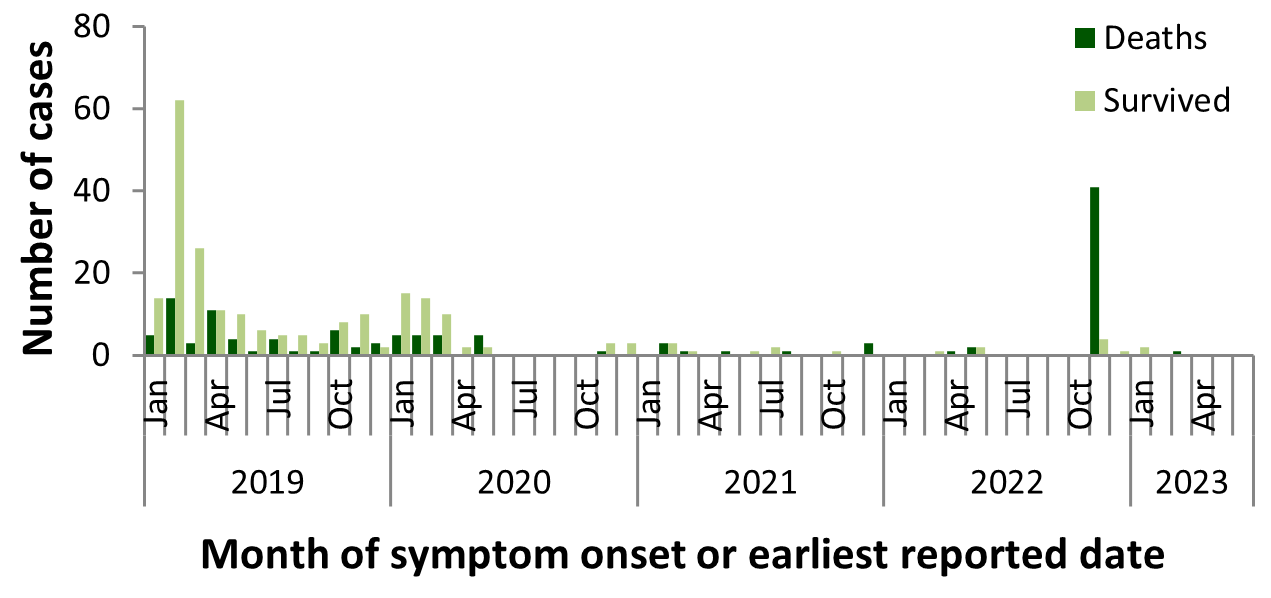
Figure 5 - Text description
| Year | Month | Deaths | Survived |
|---|---|---|---|
| 2019 | Jan | 5 | 14 |
| Feb | 14 | 62 | |
| Mar | 3 | 26 | |
| Apr | 11 | 11 | |
| May | 4 | 10 | |
| June | 1 | 6 | |
| July | 4 | 5 | |
| Aug | 1 | 5 | |
| Sep | 1 | 3 | |
| Oct | 6 | 8 | |
| Nov | 2 | 10 | |
| Dec | 3 | 2 | |
| 2020 | Jan | 5 | 15 |
| Feb | 5 | 14 | |
| Mar | 5 | 10 | |
| Apr | 0 | 2 | |
| May | 5 | 2 | |
| June | 0 | 0 | |
| July | 0 | 0 | |
| Aug | 0 | 0 | |
| Sep | 0 | 0 | |
| Oct | 0 | 0 | |
| Nov | 1 | 3 | |
| Dec | 0 | 3 | |
| 2021 | Jan | 0 | 0 |
| Feb | 3 | 3 | |
| Mar | 1 | 1 | |
| Apr | 0 | 0 | |
| May | 1 | 0 | |
| June | 0 | 1 | |
| July | 0 | 2 | |
| Aug | 1 | 0 | |
| Sep | 0 | 0 | |
| Oct | 0 | 1 | |
| Nov | 0 | 0 | |
| Dec | 3 | 0 | |
| 2022 | Jan | 0 | 0 |
| Feb | 0 | 0 | |
| Mar | 0 | 1 | |
| Apr | 1 | 0 | |
| May | 2 | 2 | |
| June | 0 | 0 | |
| July | 0 | 0 | |
| August | 0 | 0 | |
| Sep | 0 | 0 | |
| Oct | 0 | 0 | |
| Nov | 41 | 4 | |
| Dec | 0 | 1 | |
| 2023 | Jan | 0 | 2 |
| Feb | 0 | 0 | |
| Mar | 1 | 1 | |
| Apr | 0 | 0 | |
| May | 0 | 0 | |
| June | 0 | 0 |
Note: Graph was prepared by the Centre for Immunization and Respiratory Infectious Diseases (CIRID) using data from the WHO Disease Outbreak News (DON) and Saudi Arabia's Ministry of Health. This graph reflects data available as of June 30, 2023. The data integrates CIRID real-time reporting with WHO DON retrospective reporting of MERS-CoV cases and deaths. In November 2022, the WHO published a Disease Outbreak News (DON) article that updated their counts with retrospective cases and deaths, which resulted in an increase of an additional 5 cases and 41 deaths compared to their previous MERS-CoV-related DON.
